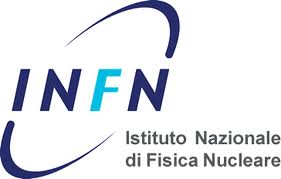CGEM detector
CGEM working principles
The Gas Electron Multiplier (GEM) electrode is a thin polymer foil, metal-coated on both sides and pierced with a high density of holes, typically 50/100 mm-2.
A large difference of potential is applied between the two sides of the foil creating a high field in the holes; electrons released in the upper region drift towards the holes and acquire enough energy to cause ionizing collisions with the molecules of the gas filling the structure. The gas is usually a mixture, typically Ar-CO 2 or Ar-iC 4 H 10 (Isobutane), where the Argon is the main gas which makes possible the ionization, while CO 2 and Isobutane are the quenching gases necessary to lower the discharge risk.
Most of the charge produced in the avalanche’s front leaves the multiplication region and transfers into the lower section of the structure, where it can be collected by an electrode, or injected into successive multiplication regions. This kind of detector, with respect to other drift devices, in particular MDC, can offer better performance in terms of resistance to discharge and aging and maximum operation rate, without trading in terms of resolution.
The triple GEM structure allows to a faster collection of the ions, which need to coverless space in order to be collected with respect to a MDC, and this results in a higher possible operation rate.
The multilayer structure performs the multiplication over multiple steps, and in this way reduces the voltages between contiguous conductive surfaces, lowering the discharge chance.
CGEM-IT
The tracker designed to be installed in BESIII consists in a three layered cylindrical detector. Each CGEM-IT layer is itself made by five concentric foils: one anode, one cathode and three GEM foils.
The ionizing particles generate the first ionization in the conversion & drift area and the signal, after the three multiplication layers, is collected on the anode.
This detector will match the experiment requirements for momentum resolution (0.5 %), radial resolution (130 μm) and time resolution (5 ns), while improving significantly the spatial resolution along the beam direction (< 200 μm) with respect to the existing drift chamber. Thanks to the Rohacell TM structure, the material budget will be less than 1.5 % X0.


